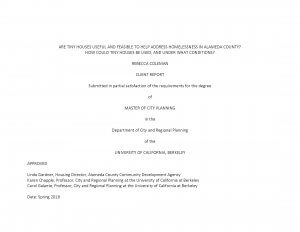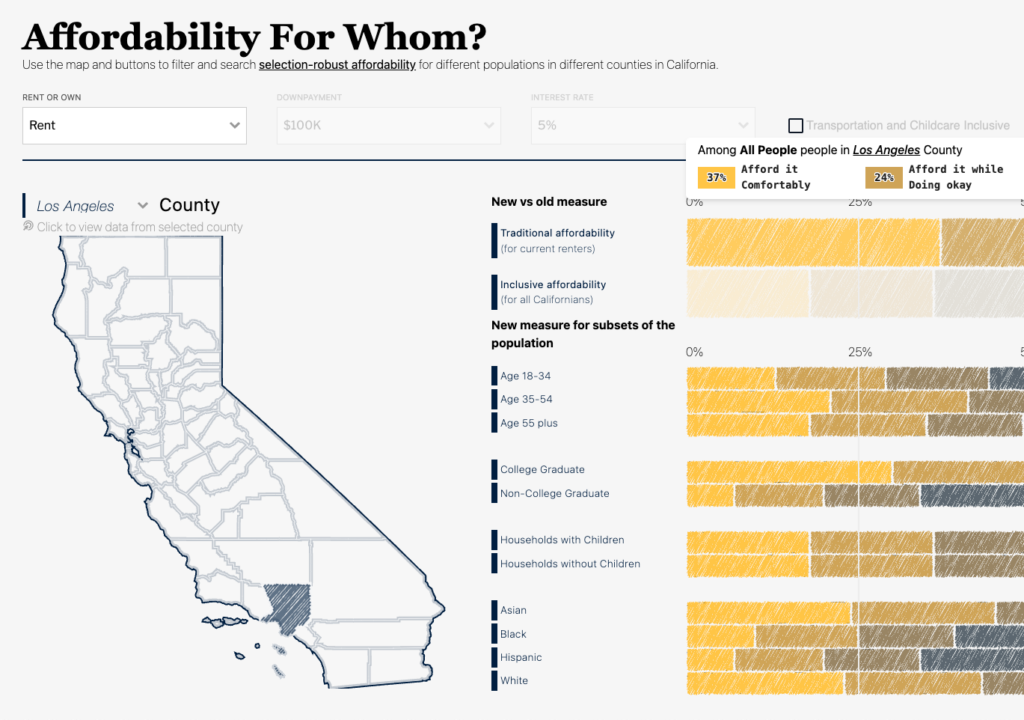Are Tiny Houses Useful and Feasible for Addressing the Homelessness Crisis?
Published On August 28, 2018

As part of our commitment to the education and professional development of UC Berkeley students, the Terner Center highlights exceptional student work that connects to our mission and research agenda. The analyses and policy proposals put forth in these projects may not be reflective of the official position of the Terner Center.
A Client Report submitted in partial satisfaction of the requirements for the degree of Master of City Planning in the Department of City and Regional Planning of the University of California, Berkeley, May 2018
Author: Rebecca Coleman
Reviewers: Linda Gardner, Karen Chapple, and Carol Galante
This report explores the application of tiny houses to Alameda County by providing background information about tiny houses for homeless individuals, including a brief history of tiny houses in the U.S. and the contemporary tiny house movement. The report next discusses the tiny house for homeless village model, including components of a successful village, challenges and opportunities for tiny house villages, and recent legislation and trends. Applications of the model are discussed, including micro-apartments, Accessory Dwelling Units (ADUs), and mobile homes. Finally, case studies of tiny house projects that are developed or underway in Oakland, Berkeley, and Hayward are presented.
Report Summary
Tiny houses are on many people’s minds as a possible solution to address our homelessness crisis. Tiny houses are by definition less than 400 square feet and cheaper than conventionally-built housing. (1) They can also be built faster and with relatively unskilled labor compared with conventional housing. Depending on their construction type and the services offered, tiny houses can offer either permanent supportive housing or rapid re-housing to provide more stability than homeless encampments. Perhaps for all of these reasons, there are over a dozen sanctioned tiny house villages for people experiencing homelessness across the U.S. with at least 75% built in 2013 or later.
According to the 2017 homeless census, there are 5,629 people experiencing homelessness in Alameda County, California alone. This is the highest it has been since at least 2009, and while this census provides a point-in-time snapshot, it is estimated that 2-3 times more people experience homelessness during the course of a year. To better understand whether tiny houses can be useful and feasible to help address homelessness, I conducted a survey of staff working at 11 tiny house villages that serve homeless individuals across the U.S. as part of the larger report, which I prepared for Alameda County Housing and Community Development, exploring the use of tiny houses for homeless individuals.
I found the characteristics of effective, functional tiny house communities for people experiencing homelessness include:
- having a local entity that is willing to put in the leg work;
- support services including placement to more stable housing options if the housing is transitional;
- a selection and approval process for residents;
- common buildings with shared facilities; and
- access to transportation if the community is not located within the city center.
Some efforts in Alameda County to pursue tiny house projects include: Tuff Shed shelters built on two sites, one leased by the City of Oakland from PG&E and one owned by CalTRANS in Oakland; development of tiny houses on wheels in a backyard in Hayward; a nonprofit that is pushing for permanent tiny houses for homeless youth in Berkeley; and a proposal to build six temporary and transitional tiny houses on wheels in a church parking lot in Castro Valley. We can see from these efforts that tiny houses can be feasible in infill locations, built on land that is already underutilized, or built provisionally on land that is owned or leased by a city to bring more services to an existing encampment.

Map: Tiny Houses for the Homeless in California: Planned and Existing as of 2018 (2)
Tiny houses are a solution that is being implemented across California. The map above shows a predicted growth from 6 existing to 18 total developments of free-standing tiny houses of varying construction types from 2004 into the foreseeable future based on data crowdsourced from The Village Collaborative and supplemented with information from secondary sources and interviews.
The state has taken note of these developments and is easing the way to using tiny houses to address homelessness. A recent change to the California Building Code creates new minimum standards for emergency housing that significantly reduces the barriers to build tiny houses for homeless people. (3) This change is significant because outside of these new minimum standards, tiny houses either need to comply with state building codes meant for conventional single family homes or to comply with RV standards – both of which can be prohibitive and out of scale with these projects. Both Berkeley and Oakland have invoked the new emergency building standards to expedite building transitional shelters for their homeless populations. (4)
Ultimately tiny houses should be pursued as part of a multi-pronged effort that includes building permanent supportive housing through large scale affordable housing projects. But we can’t wait for these developments to be built to address our homelessness crisis. To make it easier to build tiny houses, public agencies can start by taking some concrete steps right now. Emergency shelters should be permitted in more zoning districts (in Alameda County the General Ordinance Code currently allows for emergency shelters only in the R-4 multiple residence district). Waiving permit fees, adopting building code standards that are unique to tiny houses rather than applying existing building standards to tiny houses, identifying additional parcels that can be zoned as mobile home parks, and compiling best practices for building tiny houses would also be important steps. The scale of the homelessness crisis demands that we bring forward our most innovative thinking.





